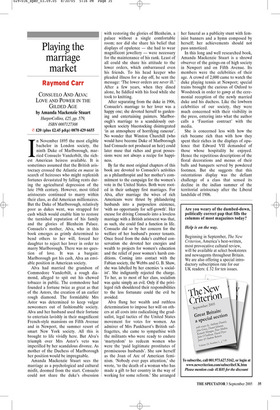Playing the marriage market
Raymond Carr
CONSUELO AND ALVA: LOVE AND POWER IN THE GILDED AGE by Amanda Mackenzie Stuart HarperCollins, £25, pp. 579, ISBN 0007127308 ✆ £20 (plus £2.45 p&p) 0870 429 6655 In November 1895 the most eligible bachelor in London society, the ninth Duke of Marlborough, married Consuelo Vanderbilt, the richest American heiress available. It is sometimes assumed that the British aristocracy crossed the Atlantic en masse in search of heiresses who might replenish fortunes devastated by falling rents during the agricultural depression of the late 19th century. However, most titled aristocrats continued to marry within their class, as did American millionaires. But the Duke of Marlborough, relatively poor as dukes went, was strapped for cash which would enable him to restore the tarnished reputation of his family and the glories of Blenheim Palace. Consuelo’s mother, Alva, who in this book emerges as grimly determined to bend others to her will, forced her daughter to reject her lover in order to marry Marlborough. There was no question of love. It was a bargain: Marlborough got his cash, Alva an enviable position in American society.
Alva had married the grandson of Commodore Vanderbilt, a rough diamond, alleged to spit out his chewed tobacco in public. The commodore had founded a fortune twice as great as that of the Astors, the creation of an earlier rough diamond. The formidable Mrs Astor was determined to keep vulgar newcomers out of fashionable society. Alva and her husband used their fortune to entertain lavishly in their magnificent French-style mansions on Fifth Avenue and in Newport, the summer resort of smart New York society. All this is brought to life vividly here. But Alva’s triumph over Mrs Astor’s veto was imperilled by her scandalous divorce. As mother of the Duchess of Marlborough her position would be impregnable.
Amanda Mackenzie Stuart sees the marriage as a psychological and cultural misfit, doomed from the start. Consuelo could not share the duke’s obsession with restoring the glories of Blenheim, a palace without a single comfortable room; nor did she share his belief that displays of opulence — she had to wear magnificent jewellery — were necessary for the maintenance of his rank. Least of all could she share his attitude to the lower orders, which embarrassed even his friends. To his head keeper who pleaded illness for a day off, he sent the message: ‘The lower orders are never ill.’ After a few years, when they dined alone, he fiddled with his food while she took to knitting.
After separating from the duke in 1906, Consuelo’s marriage to her lover was a happy one; she devoted herself to gardening and entertaining painters. Marlborough’s marriage to a scandalously outspoken society bluestocking disintegrated ‘in an atmosphere of horrifying rancour’. No wonder that Winston Churchill (who would have become Duke of Marlborough had Consuelo not produced an heir) could later muse that riches and great possessions were not always a recipe for happiness.
By far the most original chapters of this book are devoted to Consuelo’s activities as a philanthropist and her mother’s commitment to the campaign for the women’s vote in the United States. Both were rooted in their unhappy first marriages. For Alva, after marriage the wives of rich Americans were thrust by philandering husbands into a purposeless existence, ‘with no opportunity for self-growth’. Her excuse for driving Consuelo into a loveless marriage with a British aristocrat was that, as such, she could find a function in life. Consuelo did so by her concern for the welfare of her husband’s poorer tenants. Once freed from the duke’s crabbed conservatism she devoted her energies and wealth to projects for women’s education and the relief of poor women’s harsh conditions. Coming into contact with the Fabian society, the Webbs and G. B. Shaw, she was labelled by her enemies ‘a socialist’. She indignantly rejected the charge. To her, as to most of her class, socialism was quite simply an evil. Only if the privileged rich shouldered their responsibilities to the less fortunate could the evil be avoided.
Alva flung her wealth and ruthless determination to impose her will on others at all costs into radicalising the gradualist, legal tactics of the United States movement for votes for women. An admirer of Mrs Pankhurst’s British suffragettes, she came to sympathise with the militants who were ready to endure ‘martyrdom’ to redeem women who were the ‘paid legitimate prostitutes of promiscuous husbands’. She saw herself as the Joan of Arc of American feminism. ‘Nobody ever pays attention,’ she wrote, ‘to the death of a woman who has made a gift to her country in the way of working for some reform.’ She arranged her funeral as a publicity stunt with feminist banners and a hymn composed by herself; her achievements should not pass unnoticed.
In this long and well researched book, Amanda Mackenzie Stuart is a shrewd observer of the goings-on of high society in Newport and on Fifth Avenue. Its members were the celebrities of their age. A crowd of 2,000 came to watch the duke playing tennis at Newport; special trains brought the curious of Oxford to Woodstock in order to gawp at the ceremonial reception of the newly married duke and his duchess. Like the lowborn celebrities of our society, they were much concerned with their visibility in the press, entering into what the author calls a ‘Faustian contract’ with the media.
She is concerned less with how the rich became rich than with how they spent their riches in the displays of opulence that Edward VII demanded of those whose hospitality he enjoyed. Hence the repetitious descriptions of the floral decorations and menus of their balls and banquets served by powdered footmen. But she suggests that this ostentatious display was the defiant challenge of a class that sensed its decline in the indian summer of the territorial aristocracy after the Liberal landslide of 1906.









































 Previous page
Previous page